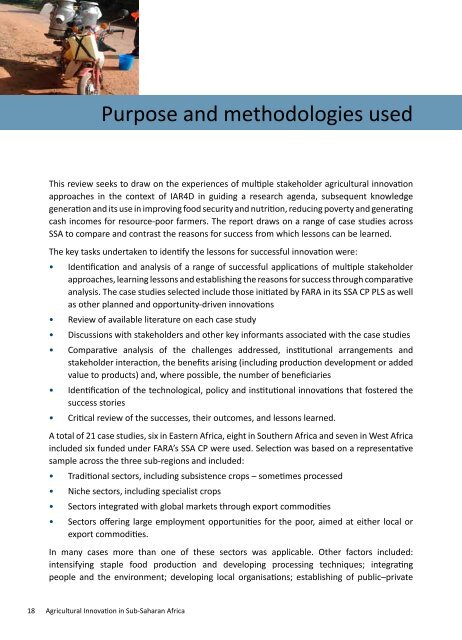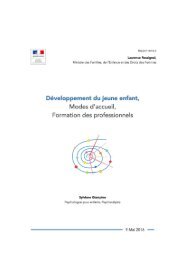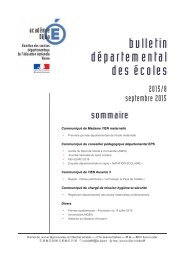agrl_innovations_in_ssa.pdf?utm_content=buffercb41d&utm_medium=social&utm_source=twitter
agrl_innovations_in_ssa.pdf?utm_content=buffercb41d&utm_medium=social&utm_source=twitter
agrl_innovations_in_ssa.pdf?utm_content=buffercb41d&utm_medium=social&utm_source=twitter
You also want an ePaper? Increase the reach of your titles
YUMPU automatically turns print PDFs into web optimized ePapers that Google loves.
Purpose and methodologies used<br />
This review seeks to draw on the experiences of multiple stakeholder agricultural <strong>in</strong>novation<br />
approaches <strong>in</strong> the context of IAR4D <strong>in</strong> guid<strong>in</strong>g a research agenda, subsequent knowledge<br />
generation and its use <strong>in</strong> improv<strong>in</strong>g food security and nutrition, reduc<strong>in</strong>g poverty and generat<strong>in</strong>g<br />
cash <strong>in</strong>comes for resource-poor farmers. The report draws on a range of case studies across<br />
SSA to compare and contrast the reasons for success from which lessons can be learned.<br />
The key tasks undertaken to identify the lessons for successful <strong>in</strong>novation were:<br />
• Identification and analysis of a range of successful applications of multiple stakeholder<br />
approaches, learn<strong>in</strong>g lessons and establish<strong>in</strong>g the reasons for success through comparative<br />
analysis. The case studies selected <strong>in</strong>clude those <strong>in</strong>itiated by FARA <strong>in</strong> its SSA CP PLS as well<br />
as other planned and opportunity-driven <strong><strong>in</strong>novations</strong><br />
• Review of available literature on each case study<br />
• Discussions with stakeholders and other key <strong>in</strong>formants associated with the case studies<br />
• Comparative analysis of the challenges addressed, <strong>in</strong>stitutional arrangements and<br />
stakeholder <strong>in</strong>teraction, the benefits aris<strong>in</strong>g (<strong>in</strong>clud<strong>in</strong>g production development or added<br />
value to products) and, where possible, the number of beneficiaries<br />
• Identification of the technological, policy and <strong>in</strong>stitutional <strong><strong>in</strong>novations</strong> that fostered the<br />
success stories<br />
• Critical review of the successes, their outcomes, and lessons learned.<br />
A total of 21 case studies, six <strong>in</strong> Eastern Africa, eight <strong>in</strong> Southern Africa and seven <strong>in</strong> West Africa<br />
<strong>in</strong>cluded six funded under FARA’s SSA CP were used. Selection was based on a representative<br />
sample across the three sub-regions and <strong>in</strong>cluded:<br />
• Traditional sectors, <strong>in</strong>clud<strong>in</strong>g subsistence crops – sometimes processed<br />
• Niche sectors, <strong>in</strong>clud<strong>in</strong>g specialist crops<br />
• Sectors <strong>in</strong>tegrated with global markets through export commodities<br />
• Sectors offer<strong>in</strong>g large employment opportunities for the poor, aimed at either local or<br />
export commodities.<br />
In many cases more than one of these sectors was applicable. Other factors <strong>in</strong>cluded:<br />
<strong>in</strong>tensify<strong>in</strong>g staple food production and develop<strong>in</strong>g process<strong>in</strong>g techniques; <strong>in</strong>tegrat<strong>in</strong>g<br />
people and the environment; develop<strong>in</strong>g local organisations; establish<strong>in</strong>g of public–private<br />
18 Agricultural Innovation <strong>in</strong> Sub-Saharan Africa






